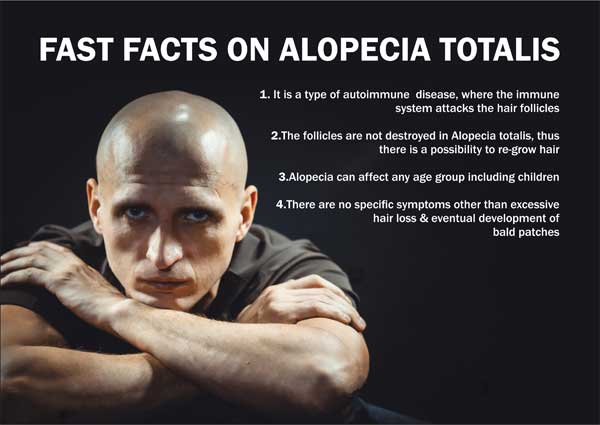Understanding Alopecia Totalis: Symptoms, Causes, and Treatment Options at NIS
Alopecia totalis, characterized by the complete loss of scalp hair, is a relatively uncommon condition affecting approximately 1 in 2000 individuals. It represents an advanced form of Alopecia areata, which manifests as hair loss in small patches. Unlike scarring alopecia, where hair follicles are destroyed, Alopecia totalis is a non-scarring alopecia, offering some potential for hair regrowth as follicles remain intact. While the precise cause remains elusive, autoimmune and genetic factors are believed to underlie this disorder, for which there is currently no definitive cure, although spontaneous hair regrowth is occasionally observed.
What is Alopecia totalis?
Alopecia totalis is a scalp disorder characterized by the complete loss of hair on the scalp, and in some cases, affecting eyebrow and eyelash hair as well. It represents an intermediate stage between Alopecia areata, marked by small round patches of hair loss, and Alopecia universalis, where hair loss extends across the entire body. Thought to be autoimmune in nature, Alopecia totalis involves the immune system targeting hair follicles, leading to inflammation without their complete destruction, unlike Cicatricial Alopecia. Thus, there remains a possibility of hair regrowth once inflammation subsides. Genetic predisposition plays a role, with Alopecia totalis often developing either suddenly or progressing from Alopecia areata. While commonly associated with older age groups, this condition can affect individuals of all ages, including children and adults under 40, with a higher prevalence observed in men than women.
Symptoms of Alopecia totalis
Symptoms of Alopecia totalis vary, with excessive hair loss from the scalp being the most prominent. Some individuals may experience itching or tightness on the scalp, while others may be asymptomatic. Hair loss typically begins with hair thinning and progresses to bald patches. Additionally, some affected individuals may exhibit brittle and pitted nails. Apart from hair loss, Alopecia totalis generally does not cause physical complications but may lead to psychological distress due to its impact on appearance.
Causes of Alopecia totalis
While the exact cause of Alopecia totalis remains unknown, genetic and autoimmune factors are implicated in its etiology. In this condition, the immune system mistakenly targets hair follicles, releasing cytokines that trigger inflammation and subsequent hair loss. Approximately 20% of affected individuals have a familial predisposition, with recent research suggesting specific genetic markers associated with the disease. Prolonged stress is also believed to influence the immune system, although scientific evidence supporting this association is limited.
Risk factors of Alopecia totalis
While the primary cause of Alopecia totalis is unclear, several risk factors contribute to its development. Genetic predisposition and familial history increase susceptibility, although individuals of any age can be affected, particularly children and those under 40. Prolonged stress is also considered a risk factor.
How is Alopecia totalis diagnosed?
Alopecia totalis is diagnosed through a thorough examination of the scalp and medical history assessment by trichologists. Biopsy and blood tests may be performed to confirm autoimmune involvement.
How to treat Alopecia totalis?
Treatment aims to manage symptoms as there is no definitive cure for hair regrowth. Therapeutic options such as immunotherapy, steroid therapy, minoxidil, and ultraviolet therapy offer limited efficacy and may carry side effects. Some individuals opt for natural remedies like essential oils, with hydroxychloroquine showing promise in certain cases. A balanced diet may also aid in prevention. Wigs provide a cosmetic solution, although Alopecia totalis often follows an unpredictable course, with limited response to therapy and potential relapse.
Understanding Complications and Prognosis
Alopecia totalis may lead to relapses even after partial hair regrowth, potentially progressing to Alopecia universalis, involving hair loss from other body areas. The prognosis is uncertain, with uncertain recovery rates and a tendency for relapse. Early detection and treatment offer hope for positive outcomes, although full recovery is rare.

Key Facts about Alopecia Totalis
– Alopecia totalis involves autoimmune-mediated hair follicle destruction.
– Hair follicles remain intact, allowing for potential hair regrowth.
– The condition can affect individuals of all ages, including children.
– Symptoms include excessive hair loss and the development of bald patches.
Recovery Rates
The recovery rate for Alopecia totalis is generally low, with a typical duration of around two years and minimal chances of hair regrowth. Given the lack of a cure and limited treatment efficacy, full recovery is unlikely. However, some cases, particularly in children, may show spontaneous improvement.


